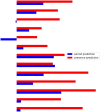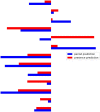Automated identification of eviction status from electronic health record notes
- PMID: 37203429
- PMCID: PMC10354775
- DOI: 10.1093/jamia/ocad081
Automated identification of eviction status from electronic health record notes
Abstract
Objective: Evictions are important social and behavioral determinants of health. Evictions are associated with a cascade of negative events that can lead to unemployment, housing insecurity/homelessness, long-term poverty, and mental health problems. In this study, we developed a natural language processing system to automatically detect eviction status from electronic health record (EHR) notes.
Materials and methods: We first defined eviction status (eviction presence and eviction period) and then annotated eviction status in 5000 EHR notes from the Veterans Health Administration (VHA). We developed a novel model, KIRESH, that has shown to substantially outperform other state-of-the-art models such as fine-tuning pretrained language models like BioBERT and Bio_ClinicalBERT. Moreover, we designed a novel prompt to further improve the model performance by using the intrinsic connection between the 2 subtasks of eviction presence and period prediction. Finally, we used the Temperature Scaling-based Calibration on our KIRESH-Prompt method to avoid overconfidence issues arising from the imbalance dataset.
Results: KIRESH-Prompt substantially outperformed strong baseline models including fine-tuning the Bio_ClinicalBERT model to achieve 0.74672 MCC, 0.71153 Macro-F1, and 0.83396 Micro-F1 in predicting eviction period and 0.66827 MCC, 0.62734 Macro-F1, and 0.7863 Micro-F1 in predicting eviction presence. We also conducted additional experiments on a benchmark social determinants of health (SBDH) dataset to demonstrate the generalizability of our methods.
Conclusion and future work: KIRESH-Prompt has substantially improved eviction status classification. We plan to deploy KIRESH-Prompt to the VHA EHRs as an eviction surveillance system to help address the US Veterans' housing insecurity.
Keywords: calibration; eviction; knowledge injection; prompt design; social and behavioral determinants of health.
© The Author(s) 2023. Published by Oxford University Press on behalf of the American Medical Informatics Association. All rights reserved. For permissions, please email: journals.permissions@oup.com.
Conflict of interest statement
None declared.
Figures


References
-
- Desmond M. Evicted: Poverty and Profit in the American City. New York City, USA: Crown; 2016.
-
- Tsai J, Huang M.. Systematic review of psychosocial factors associated with evictions. Health Soc Care Community 2019; 27 (3): e1–9. - PubMed
-
- Desmond M, Kimbro RT.. Eviction’s fallout: housing, hardship, and health. Social Forces 2015; 94 (1): 295–324.
Publication types
MeSH terms
Grants and funding
LinkOut - more resources
Full Text Sources
Medical

